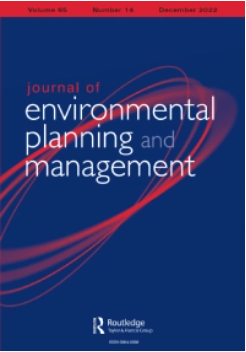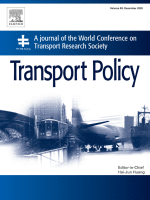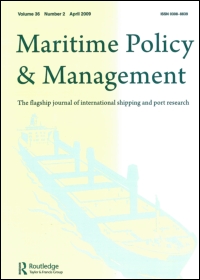环境效率评价
-
Exploring the environmental efficiency of airlines through a parallel RAM approach
Air pollution in the aviation industry is becoming increasingly severe worldwide, along with rapid economic development. Therefore, it is significant to pay close attention to airlines worldwide. Usually, the airlines contain passenger transportation and freight transportation on the operating move. This paper proposes a parallel range adjusted measure (PRAM) to comprehensively measure and evaluate the environmental efficiency of 18 airlines from 2014 to 2019. Different from existing models, the model can handle shared inputs, shared desirable outputs, and shared undesirable outputs simultaneously. We build a shared resource decomposition procedure to perform a comparative analysis of the highest subsystem efficiency, and the sensitivity analysis proves the validity of the results. The main findings are as follows: 1. The optimal efficiency can be achieved by most of the 18 airlines when sharing resources; 2. Operating costs in the freight system should be increased to achieve optimal efficiency; 3. Asian airlines show higher efficiency than the airlines in Europe.
-
A data-based comparison of the five undesirable output disposability approaches in airline environmental efficiency
The carbon emissions of airlines are growing rapidly, so if we intend to evaluate the airlines’ environmental efficiency, carbon emissions should be a kind of undesirable output. Five disposability approaches for undesirable output have been proposed, but no data-based empirical study has been done to compare them. In this paper, we define Greenhouse gas emission as the undesirable output and select Number of Employees, Fleet Size, Sales Costs, and Aviation Kerosene as the inputs, the desirable outputs are Revenue Passenger Kilometers and Total Revenue. The data of 29 international airlines from 2008 to 2014 are applied to compare the disposability approaches in airline environmental efficiency. The main findings are: 1. By-production model has the best performance in distinguishing airline environmental efficiency. 2. Unified natural disposability & managerial disposability does well in deciding efficient airlines and in deciding the airlines with the lowest efficiency. 3. The undesirable output related indices have a more important role in the efficiency change of by-production model.
-
A cross efficiency distinguishing method to explore the cooperation degree in dynamic airline environmental efficiency
The aviation industry's carbon emissions have aroused a wide concern as the global airlines had discharged about 915 million tons CO2 in 2019. The airlines have taken many measures to control emissions. However, existing studies have not considered the role of cooperation or competition in evaluating the effects of controlling emissions. We build a dynamic structure for airline environmental efficiency and two Dynamic Benevolent Environmental DEA Cross-efficiency model and Dynamic Aggressive Environmental DEA Cross-efficiency model to evaluate the airline dynamic environmental efficiency. Then we apply a cross efficiency distinguishing method to reflect the degree of cooperation and competition in airline environmental efficiency. Then, the models are applied to assess the efficiency of 29 global airlines from 2010 to 2016. The empirical analysis results confirm the reasonability of the models. The results show that most airlines have a relationship in which the cooperation is larger than the competition in 2010 and 2012, but they have a relationship that both competition and cooperation coexist in other years.
-
Investigating the impacts of the EU ETS emission rights on airline environmental efficiency via a Network Environmental SBM model
Based on empirical data from 18 international airlines from 2008 to 2014, this article analyzes the impact of EU emission rights on airline environmental efficiency and calculates the airlines’ emission allowances. Then, we propose a Network Environmental Slack-Based Measure model to discuss the change in efficiency when carbon prices are set at 10, 20 and 30 Euros. The main findings are as follows: (1) Eva Air is the airline with the highest average overall efficiency. (2) For most airlines, their efficiency shows little difference from the original situation, regardless of the carbon price. (3) For airlines with large changes in efficiency, the cost or income from emission rights not only affects the operating expenses but also the fleet size.
-
Exploring the impacts of EU ETS on the pollution abatement costs of European airlines: An application of Network Environmental Production Function
In this paper, we investigate the impacts of the EU ETS on airlines' pollution abatement costs based on the empirical data of 12 European airlines. We propose a new Network Environmental Production Function to discuss the change of pollution abatement costs between the situations under EU ETS and without EU ETS. We also discuss the impacts of “Take off the European referendum” on UK airlines. The main findings are: 1. Ryanair has the largest pollution abatement costs while those of Lufthansa and Norwegian are zero. 2. The “Take off the European referendum” has no direct impacts on the pollution abatement costs of UK-based carriers. 3. The EU ETS has little influence on the pollution abatement costs of most of the airlines, and a broader package of measures should be necessary.
-
Environmental efficiency measures for ports: an application of RAM-Tobit-RAM with undesirable outputs
In this paper, the environmental efficiency of the ports is measured. Labour, fund and infrastructure input are selected as the inputs, container throughput, cargo throughput and main business income are selected as the outputs, CO2 emission is chosen as the undesirable output. A new model—RAM-Tobit-RAM (Range Adjusted Measure) with undesirable outputs is built to evaluate the environmental efficiency. Ten Chinese ports from 2004 to 2013 are taken as the samples to verify its rationality. The results suggest that it is not necessarily beneficial for environmental efficiency to expand the port scale.






